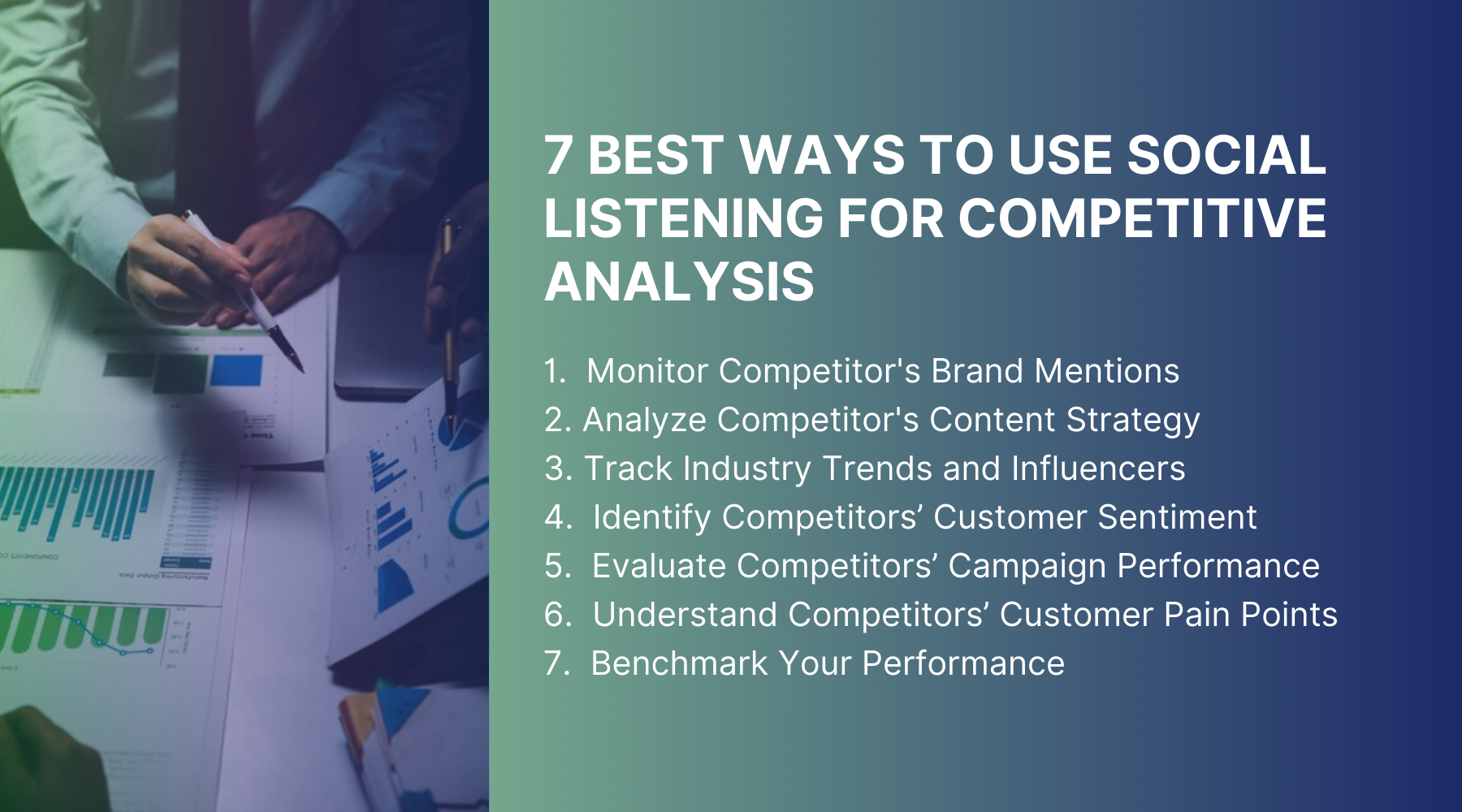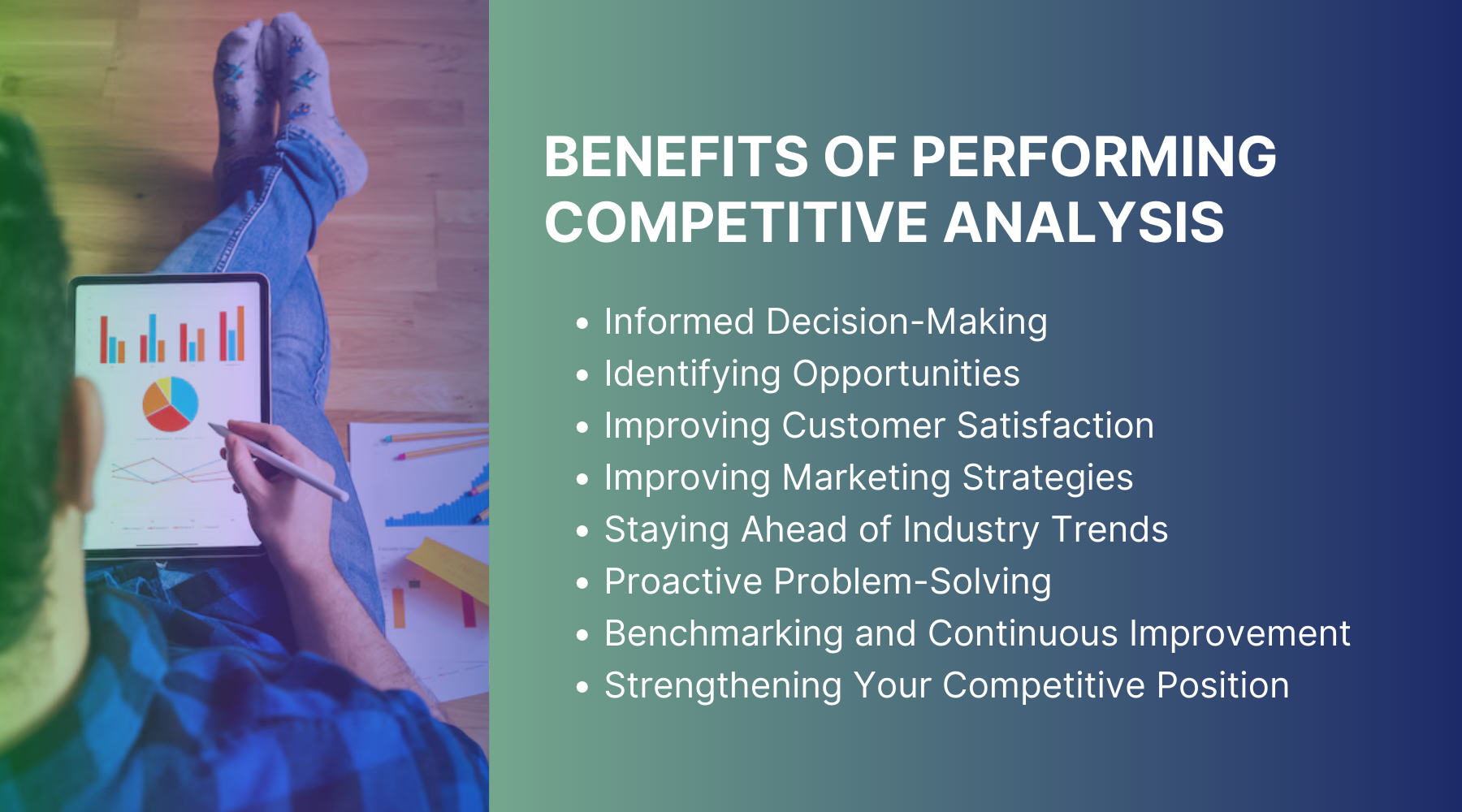Social Listening
7 Best Ways to Use Social Listening for Competitive Analysis
Jul 15, 2024
With businesses expanding each day, traditional market research alone is insufficient. Social listening has evolved into a significant tool for businesses, offering real-time insights into competitors' strategies, customer sentiment, and industry trends. This advanced approach goes beyond traditional market research, allowing you to predict market shifts and respond swiftly.
The social listening approach not only helps in understanding market dynamics but also in predicting shifts before they occur. Ultimately, social listening allows your businesses to adapt swiftly and strategically in an ever-changing market environment.
Here are seven advanced strategies for using social listening to gain insights into competitors' strategies, customer sentiment, and industry trends for competitive analysis.
What is Competitive Analysis?
Competitive analysis involves evaluating your competitors to understand their strengths, weaknesses, strategies, and market positioning. It helps businesses identify opportunities, benchmark their performance, and develop strategies to gain a competitive edge. Traditional competitive analysis methods include reviewing competitors' websites, marketing materials, financial reports, and customer reviews.
However, with the rise of social media and online communities, social listening has become a vital component of comprehensive competitive analysis.
Why Competitive Analysis is important?
Competitive analysis is more significant for businesses, providing the insights needed for best decision-making and identifying market opportunities. According to a, companies that perform regular competitive analysis are 2.5 times more likely to be market leaders in their industry. By understanding competitors' strengths and weaknesses, you can improve customer satisfaction and refine your strategic planning.
This analysis also aids in performance benchmarking, allowing you to measure your performance against industry standards. A report by Harvard Business Review highlights that businesses using competitive analysis for innovation are 30% more likely to introduce successful new products.
Furthermore, competitive analysis is vital for risk management and developing effective marketing strategies. By understanding your competitors, you can improve your offerings to retain customers better. Continuous competitive analysis ensures agility and adaptability, positioning your business for long-term success in a dynamic market.
7 Best Ways to Use Social Listening for Competitive Analysis

1. Monitor Competitor's Brand Mentions
Tracking your competitors' brand mentions across social media platforms and online communities allows you to understand how their customers perceive them. Analyzing the sentiment and context of these mentions can help you identify their strengths and weaknesses, customer pain points, and areas where your business can improve. This information can be used to refine your marketing strategies and improve customer engagement.
Use social listening tools like Brandwatch or to track your competitors' brand mentions across various social media platforms and online communities.
2. Analyze Competitor's Content Strategy
Social listening can provide insights into the type of content your competitors are producing, how often they post, and the engagement their content receives. By understanding their content strategy, you can identify gaps in their approach and create more compelling content that resonates with your target audience. This can help you attract and retain customers who might be dissatisfied with your competitors' offerings.
3. Track Industry Trends and Influencers
Staying updated on industry trends and influencers is crucial for maintaining a competitive edge. Social listening tools can help you identify trending topics, hashtags, and influential voices within your industry. Set up social listening tools like Hootsuite to monitor industry-specific keywords and hashtags. By understanding what topics are gaining traction and who is leading the conversation, you can position your brand as a thought leader and align your marketing efforts with current trends.
4. Identify Competitors’ Customer Sentiment
Compare your social media performance metrics, such as engagement rates, follower growth, and share of voice, with those of your competitors. Use social listening tools to track these metrics over time. Identify areas where your competitors excel and where they fall short. Leverage this data to set realistic benchmarks for your performance and develop strategies that close the gaps and capitalize on your competitors' weaknesses.
5. Evaluate Competitors’ Campaign Performance
Monitoring the performance of your competitors' marketing campaigns can provide insights into what works and what doesn't. Use tools like Brandwatch and Hootsuite to monitor your competitors' marketing campaigns. Track metrics such as reach, engagement, and sentiment for their campaigns. This information can guide your campaign planning and execution, enabling you to create more effective and impactful marketing initiatives.
6. Understand Competitors’ Customer Pain Points
Social listening can help you identify common pain points and complaints that customers have about your competitors. Monitor social media channels, forums, and review sites using tools like Sprinklr and Mention. Set up keyword alerts for common complaints and pain points about your competitors. Analyze this feedback to identify recurring issues customers face. Address these issues in your products or services to attract dissatisfied customers and position your brand as a better alternative.
7. Benchmark Your Performance
Using social listening to benchmark your performance against competitors allows you to measure your brand's visibility, engagement, and sentiment in comparison to others in your industry. Regularly use social listening tools like Sprout Social and Brandwatch to track your brand's visibility, engagement, and sentiment compared to your competitors. Set up automated reports to monitor these metrics.
This helps you identify areas where you are excelling and areas that need improvement. By continuously monitoring and benchmarking your performance, you can make data-driven decisions to optimize your strategies and maintain a competitive edge.
Benefits of Performing Competitive Analysis

Informed Decision-Making
Competitive analysis provides the data and insights necessary to make well-informed business decisions. By understanding your competitors' strategies, market positioning, and customer preferences, you can develop more effective marketing, product development, and customer service strategies. This knowledge enables you to predict market shifts, react quickly to industry changes, and strategically plan for the future.
Identifying Opportunities
Through competitive analysis, you can uncover opportunities that your competitors may have missed or underutilized. Social listening allows you to stay attuned to emerging trends, unmet customer needs, and gaps in the market. By capitalizing on these opportunities, you can create unique value propositions that differentiate your brand and attract new customers.
Improving Customer Satisfaction
By analyzing competitors' strengths and weaknesses, you can identify areas where your products or services can be improved. Understanding what customers like and dislike about your competitors helps you tailor your offerings to better meet their needs. This proactive approach to product and service improvement leads to higher customer satisfaction, loyalty, and retention.
Improving Marketing Strategies
Competitive analysis helps you understand what marketing strategies are working for your competitors and which ones are falling flat. By studying their content, campaigns, and customer engagement, you can refine your marketing efforts to resonate more effectively with your target audience. This knowledge enables you to create compelling, data-driven marketing strategies that drive better results.
Staying Ahead of Industry Trends
Social listening keeps you updated on the latest industry trends and influencer conversations. By staying informed about what’s trending and who’s influencing your industry, you can align your marketing efforts with current trends and position your brand as a thought leader. This proactive approach ensures that your business remains relevant and competitive in a constantly evolving market.
Proactive Problem-Solving
Identifying competitors' customer pain points and complaints allows you to address similar issues in your offerings before they become significant problems. By proactively solving these issues, you can improve customer satisfaction and prevent potential negative feedback. This approach not only helps you retain customers but also attracts those who are dissatisfied with your competitors.
Benchmarking and Continuous Improvement
Using social listening for competitive analysis allows you to benchmark your performance against that of your competitors. By regularly measuring your brand’s visibility, engagement, and sentiment in comparison to others in your industry, you can identify areas for improvement and track your progress over time. This continuous improvement process ensures that your business remains agile, competitive, and responsive to market changes.
Strengthening Your Competitive Position
Ultimately, competitive analysis helps you strengthen your position in the market. By understanding your competitors' strategies and performance, you can develop and implement tactics that improve your market presence. This knowledge allows you to craft a more compelling value proposition, improve your offerings, and strategically target your marketing efforts, ensuring your business stands out in a crowded marketplace.
Incorporating competitive analysis into your business strategy provides a comprehensive understanding of the competitive landscape, enabling you to make informed decisions, seize opportunities, and maintain a competitive edge.
Conclusion
Incorporating social listening into your competitive analysis can benefit your business in a significant way. By keeping an eye on competitors' mentions, analyzing their content, tracking industry trends, evaluating campaign success, and understanding customer sentiment, you'll be equipped to make smarter decisions and stay relevant.
Beyond gaining a competitive edge, this approach can improve customer satisfaction, refine your marketing strategies, and help you solve problems proactively. Learn how to use social listening so your business can not only survive but also grow in today's constantly changing digital world.

Data Analytics
Jun 27, 2024Master key concepts in data analytics with practical tips to enhance decision-making and achieve success in your projects and professional growth

Data Analytics
Jul 01, 2024Learn the essential stages of the data analytics workflow to turn your data into valuable business insights and drive growth.

